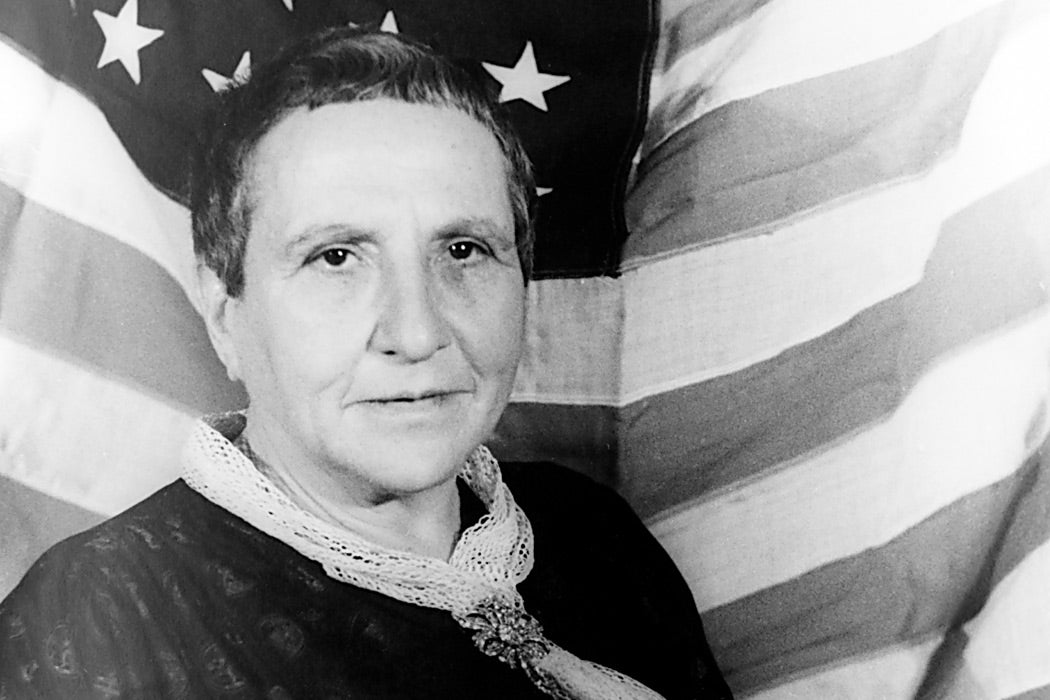Gertrude Stein believed that she was a literary genius long before anybody else did. The trouble was in convincing others—especially when so little of her work was in print.
Stein achieved a long-desired breakthrough when the Atlantic magazine published selections from Stein’s The Autobiography of Alice B. Toklas in 1933. The serialization and book publication that followed made Stein a literary celebrity, giving rise an American lecture tour that took Stein from New York City to Milwaukee to Alabama.
Stein’s breakthrough is all the more remarkable because it came at the age of 59, after a fourteen-year campaign to enter its pages. While Stein would defensively declare in 1930, “Lack of popular success in America is the last of my worries,” her correspondence with the Atlantic tells a different story. Rare is the writer as brazen or as persistent about her desire to be in one publication, which Stein describes, in an attempt to flatter the editor, as America’s “only literary magazine.”
In an article entitled “Stein and the Marketplace,” Bryce Conrad draws on a bouquet of letters between Stein and the Atlantic’s editor-in-chief, Ellery Sedgwick, published in the Yale University Library Gazette in 1954, after Stein’s death. The correspondence dates back to 1919, when Stein sent the Atlantic three poems to consider for publication. The magazine declined, leading Stein to protest, “my stuff has genuine literary quality, frankly let us say the only important literature to come out of America since Henry James.”
Aside from the not atypical braggadocio, Stein hoped with to use the comparison to exploit James’ hometown connection with the magazine: “To be sure [James] was connected with the heart of Boston but then I did graduate from Radcliffe and was a favorite pupil of William James and that combination ought to encourage the Atlantic to take a chance.”
Stein sent the Atlantic numerous original submissions and also tried to persuade the magazine to review her magnum opus The Making of Americans when it was finally published in 1925, all to no avail. Nor was the Atlantic interested in Stein’s now-canonical lecture “Composition as Explanation,” delivered at Oxford in 1926 and published in England by Virginia and Leonard Woolf’s Hogarth Press. The following rejection from Sedgwick was typical: “not one of our readers in a thousand would understand your essay, regardless of the explanatory note.” To add insult to injury, the magazine published a negative review of Stein’s work without having given their readers opportunity to peruse the writing itself. Stein protested to Sedgwick, “I cannot feel it possible that you could be willing to print something about something and not print the thing itself, could you.” The Atlantic could, and did.
Fourteen years after Stein’s first submission, the Atlantic performed a sudden volte-face in 1933, publishing four segments of The Autobiography, a work of “audience writing” that Stein produced with the explicit intent to gain a readership for her more difficult writings. Stein did not even have the pleasure of a successful end to her campaign, for the manuscript was originally submitted by an agent without Stein’s name attached. The Autobiography’s relative lucidity astonished Sedgwick. He wrote to Stein unsolicited, reporting that the “serialization has been a great success.” He added, in words that would have been gratifying to Stein had they been true, “All the new fans are running to your bookstores to ask about your other works, and then an explosion is apt to occur.”
Alas, the capitulation to public tastes that Stein performed when writing The Autobiography did not bring readers to her more challenging modernist writings, such as Tender Buttons or Stanzas in Meditation (the latter, like much of Stein’s writing, unpublished at her death). After the lecture tour, Stein would lament, “It always did bother me that the American public were more interested in me than in my work. And after all there is no sense in it because if it were not for my work they would not be interested in me so why should they not be more interested in my work than in me.” Known by many, read by few, Stein’s strange encounters with celebrity would come to occupy the last phase of her writing career before her death in 1946. However befuddling to her, Stein’s celebrity, and her subsequent reflection on it in works like Ida and Doctor Faustus Lights the Lights, only add to her posthumous importance as a writer of the American experience.







